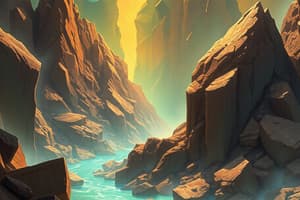Podcast
Questions and Answers
What is a mineral deposit?
What is a mineral deposit?
- Naturally-occurring material from which minerals can be extracted.
- A concentration of minerals that is of scientific interest.
- Any rock that contains metals but at low concentrations.
- A mineral occurrence that can be extracted profitably. (correct)
Which of the following materials is considered a non-metallic resource?
Which of the following materials is considered a non-metallic resource?
- Copper
- Fluorite (correct)
- Platinum
- Iron
How do hydrothermal ore deposits form?
How do hydrothermal ore deposits form?
- As a result of volcanic eruptions releasing minerals.
- By hot, aqueous fluids moving through rock fractures. (correct)
- From the weathering of surface rocks over time.
- Through the cooling of igneous rocks in water.
What process is primarily responsible for the concentration of metallic mineral deposits?
What process is primarily responsible for the concentration of metallic mineral deposits?
Which of the following is NOT a characteristic of an ore deposit?
Which of the following is NOT a characteristic of an ore deposit?
What is meant by 'aggregate' in the context of mineral resources?
What is meant by 'aggregate' in the context of mineral resources?
Which processes contribute to the formation of magmatic ore deposits?
Which processes contribute to the formation of magmatic ore deposits?
What role do geologic processes play in mineral resource concentration?
What role do geologic processes play in mineral resource concentration?
Which type of ore deposit is formed from the concentration of valuable substances through chemical precipitation from bodies of water?
Which type of ore deposit is formed from the concentration of valuable substances through chemical precipitation from bodies of water?
What is the main factor influencing the formation of residual ore deposits?
What is the main factor influencing the formation of residual ore deposits?
Which type of ore deposit is primarily associated with gravity separation during sedimentary processes?
Which type of ore deposit is primarily associated with gravity separation during sedimentary processes?
Iron formations typically consist of repetitive layers of which type of minerals?
Iron formations typically consist of repetitive layers of which type of minerals?
In which environment are evaporite deposits most likely to form?
In which environment are evaporite deposits most likely to form?
Which factor does NOT significantly affect the formation of residual ore deposits?
Which factor does NOT significantly affect the formation of residual ore deposits?
What contributes to the concentration of valuable substances in placer deposits?
What contributes to the concentration of valuable substances in placer deposits?
Which of the following is a common example of a residual ore deposit?
Which of the following is a common example of a residual ore deposit?
Flashcards are hidden until you start studying
Study Notes
Mineral as a Resource
- Mineral Occurrence: Concentration of a mineral that holds scientific or technical interest.
- Mineral Deposit: Sufficient size and concentration enabling profitable extraction.
- Ore: Naturally occurring material from which economic minerals can be extracted.
- Ore Deposit: Tested mineral deposit known to be economically profitable.
- Aggregate: Nonmetallic rock or mineral material used in construction, such as cement or asphalt.
Mineral Deposits
- Earth's crust rocks contain metals and elements at low concentrations.
- Geologic processes concentrate minerals in specific areas, enhancing their availability.
Types of Mineral Resources
- Metallic Resources: Include valuable metals like gold, silver, copper, platinum, and iron.
- Non-metallic Resources: Include talc, fluorite, sulfur, sand, and gravel.
Occurrence of Mineral Resources
- The rock cycle plays a significant role in the accumulation and concentration of valuable minerals.
- Plate tectonics can concentrate minerals in certain geographical regions.
Classification of Ore Minerals
- Magmatic Ore Deposits: Formation occurs through magmatic processes such as crystal fractionation and partial melting.
- Hydrothermal Ore Deposits: Formed by hot water-rich fluids that flow through rocks, concentrating dissolved metals.
- Types include Vein Type, Disseminated, Massive Sulfide, and Stratabound Deposits.
- Sedimentary Ore Deposits: Created through chemical precipitation in bodies of water.
- Includes Evaporite Deposits and Iron Formations (layers of iron-rich minerals).
- Placer Ore Deposits: Formed by gravity separation during sedimentary processes, often involving heavy minerals.
- Residual Ore Deposits: Result from chemical weathering, leading to accumulation of valuable materials like bauxites and nickeliferous laterites. Factors influencing their formation include rock composition, climate, and relief.
Studying That Suits You
Use AI to generate personalized quizzes and flashcards to suit your learning preferences.




